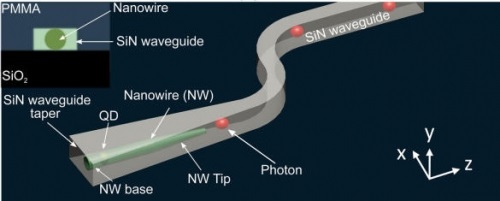March 30, 2016
Researchers have successfully integrated an on-demand light source in a silicon-based chip, the first fully integrated quantum optics approach that is compatible with current technology in the semiconductor industry, such as existing computer processors and memories.
Fully integrated quantum optics involves scaling down the components of a quantum optics lab to fit into one chip. This includes a quantum light source generated by a stream of tiny particles of light called photons, waveguide channels and beam splitters to manipulate photons, and photon detectors. A single chip with all of these capabilities to generate, manipulate and measure photons may be used to perform quantum operations, such as simulation or factoring at the single photon level. This type of quantum computing is called linear optical quantum computing (LOQC).
Institute for Quantum Computing (IQC) faculty member Michael Reimer was among the researchers collaborating on this project with others from the Delft University of Technology, The Netherlands, the Royal Institute of Technology, Stockholm and the National Research Council of Canada, Ottawa. Reimer completed a postdoctoral fellowship at Delft, where the experiment was performed.
The team of researchers used quantum dots – small crystal-like semiconductor structures that convert energy into photons – as a quantum light source. Preselected nanowire samples with a single quantum dot were transferred onto silicon-based photonic circuits. The researchers fabricated silicon nitride waveguides around the nanowire, perfectly aligning the quantum dot dipoles with the electrical nodes of the waveguide, resulting in excellent coupling from the quantum light source to the waveguide. An optical pulse was used to excite the quantum dot and emit a photon that moves through the circuit along the waveguide with high transmission (low loss).
This demonstration of a fully integrated quantum optics circuit satisfies the requirements for an operational LOQC system. It is also promising for future quantum technology research. “This advancement in quantum technology hardware could lead to the development of advanced photonic circuits to perform quantum operations and new devices for extending the distance of quantum communication, such as tunable entangled photon sources – an essential element of a quantum repeater,” said Reimer, also an assistant professor in the Department of Electrical and Computer Engineering. “By scaling this quantum technology up to realize multi-photon entanglement in the future, it could also be used in other applications such as ultra low-power, non-invasive quantum imaging.”
Nano Letters published the article Deterministic Integration of Single Photon Sources in Silicon Based Photonic Circuits online March 8.













